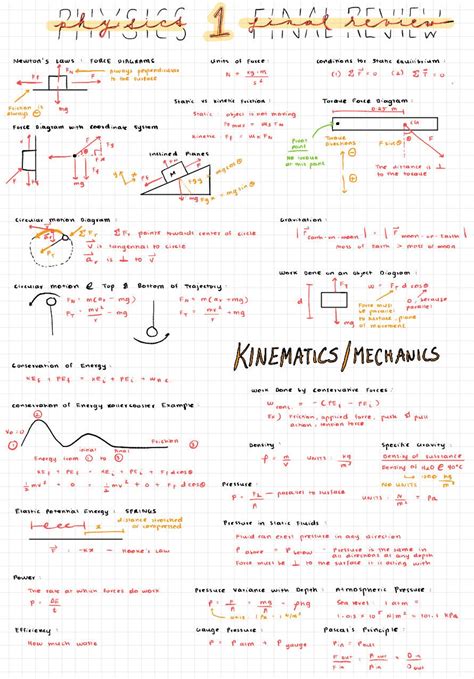Kinematics

Motion
* Displacement: Δx = xf – xi
* Velocity: v = Δx/Δt or v = d/t
* Acceleration: a = Δv/Δt or a = (vf – vi)/t
Projectile Motion
* Horizontal component: v = d/t
* Vertical component: y = d + 1/2at^2
* Total distance: s = d + h
* Total time: t = t1 + t2
Dynamics
Newton’s Laws
* First Law: An object at rest stays at rest, and an object in motion stays in motion at constant speed and in a straight line unless acted on by an unbalanced force.
* Second Law: The acceleration of an object is directly proportional to the net force acting on the object and inversely proportional to its mass. (F = ma)
* Third Law: For every action, there is an equal and opposite reaction.
Friction
* Static friction: Fs ≤ μsFn
* Kinetic friction: Fk = μkFn
Work and Energy
Work
* Work done by a constant force: W = Fdcosθ
* Power: P = W/t
Energy
* Kinetic energy: Ek = 1/2*mv^2
* Potential energy: Ep = mgh
* Law of conservation of energy: Energy cannot be created or destroyed, only transferred or transformed.
Momentum
Impulse
* Impulse: J = Δp
* Δp = Ft
Momentum
* Momentum: p = mv
* Law of conservation of momentum: In the absence of external forces, the total momentum of a system remains constant.
Rotational Motion
Torque
* Torque: τ = rFsinθ
Rotational inertia
* Rotational inertia: I = mr^2
Angular acceleration
* Angular acceleration: α = Δω/Δt
Circular Motion
* Centripetal acceleration: ac = v^2/r
Fluids
Density
* Density: ρ = m/V
Buoyancy
* Buoyant force: Fb = ρVg
* Archimedes’ principle: An object submerged in a fluid experiences an upward buoyant force equal to the weight of the fluid displaced by the object.
Tables
| Kinematics | Dynamics | Work and Energy | Momentum |
|---|---|---|---|
| Displacement: Δx | Newton’s First Law | Work: W = Fdcosθ | Impulse: J = Δp |
| Velocity: v | Newton’s Second Law | Power: P = W/t | Momentum: p = mv |
| Acceleration: a | Newton’s Third Law | Kinetic energy: Ek = 1/2*mv^2 | Law of conservation of momentum |
| Projectile Motion | Friction | Potential energy: Ep = mgh |
| Rotational Motion | Fluids | Constants |
|---|---|---|
| Torque: τ = rFsinθ | Density: ρ = m/V | Gravitational acceleration: g = 9.8 m/s^2 |
| Rotational inertia: I = mr^2 | Buoyancy: Fb = ρVg | |
| Angular acceleration: α = Δω/Δt | Archimedes’ principle | |
| Circular Motion |
Common Mistakes to Avoid
- Confusing displacement, velocity, and acceleration
- Ignoring the direction of vectors
- Using incorrect units
- Not considering all forces acting on an object
- Not applying the correct equation in the correct situation
FAQs
1. What is the difference between speed and velocity?
Speed is the rate at which an object moves, while velocity is the rate at which an object moves in a specific direction.
2. What is the difference between mass and weight?
Mass is the amount of matter in an object, while weight is the force exerted on an object due to gravity.
3. What is the difference between work and energy?
Work is the transfer of energy, while energy is the ability to do work.
4. What is the difference between momentum and impulse?
Momentum is the mass of an object multiplied by its velocity, while impulse is the change in momentum of an object.
5. What is the difference between torque and angular momentum?
Torque is a force applied at a distance from the axis of rotation, while angular momentum is the product of an object’s moment of inertia and its angular velocity.
6. What is the difference between centripetal force and centrifugal force?
Centripetal force is a force that pulls an object towards the center of a circular path, while centrifugal force is a fictitious force that appears to push an object away from the center of a circular path.
